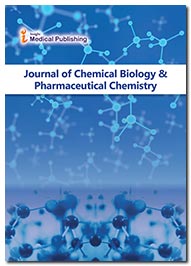ISSN : 2634-7814
Journal of Chemical Biology & Pharmaceutical Chemistry
Pharmacist's Role in Clinical Pharmacokinetic Monitoring
Malina Jasamai*
Department of Chemistry Abdul Wali Khan University Mardan,Pakistan
*Corresponding author: Malina Jasamai, Department of Chemistry Abdul Wali Khan University Mardan, Pakistan, E-mail: jasamailina@gmail.com
Received date: 07 June, 2021; Accepted date: 21 June, 2021; Published date: 28 June, 2021
Editorial Note
Clinical pharmacological medicine is that the method ofapplying pharmacokinetic principles to work out the doseregimens of specific drug merchandise for specificpatients tomaximize pharmaco therapeuticeffects and minimize healthfuleffects. Pharmacological medicine (from Hellenic pharm Akon"drug" and kinetics "moving, fittingmotion"; see chemicalkinetics), typically abbreviated as PK, could be a branch ofmaterial medical dedicated to work out the fate of gearadministered to a living organism. The substances of interestembrace any chemical xenobiotic such as: pharmaceuticalmedicine, pesticides, food additives,cosmetics, etc. It tries toinvestigate chemical metabolism and to get the fate of achemical from the instant that it's administered up to thepurpose at that it's fully eliminated from the body.Pharmacological medicine is that the study of however associatedegree organism affects a drug, whereas Pharmaco Dynamics(PD) is that the study of however the drug affects the organism.Each along influence dosing, benefit, and adverse effects, asseen in PK/PD models.
Think of pharmacological medicine as a drug's journeythrough the body, throughout that it passes through fourcompletely different phases: Absorption,Distribution,Metabolism and Excretion (ADME). Drug interactions occur onpharmacodynamics and pharmacokinetic levels. Digoxin, notablyonce given intravenously, is associate degree example of a drugthat's well represented by two- compartment pharmacologicalmedicine. When associate degree blood vessel dose is run,plasma concentrations rise and so speedily decline as drugdistributes out of plasma and into muscle tissue. Samples ofpharmacodynamics interactions square measure concurrentadministration of a NSAID and phenprocoumon (additiveinteraction), or of Empiric and Advil (antagonisticinteraction).The four steps are: Absorption: Describes however the drugmoves from the location of administration to the location ofaction.
The activity of medication within the body over an amount ofyour time, together with the processes by that medicine squaremeasure absorbed, distributed within the body, localized withinthe tissues, and excreted. Therapeutic Drug Observance (TDO) istesting that measures the number of bound medicines in yourblood. It’s done to create certain the number of medicationyou're taking is each safe and effective. Clinical pharmacists:Assess the standing of the patient's health issues and verifywhether or not the prescribed medications square measureoptimallymeeting the patient's desires and goals of care.valuate the appropriateness and effectiveness of the patient'smedications. Clinical pharmacological medicine is that thediscipline that describes the absorption,distribution,metabolism, and elimination of medication in patients requiringdrug medical aid.
Pharmacodynamics (sometimes represented as what a drugwill to the body) is that the study of the organic chemistry,physical, and molecular effects of medication on the body andinvolves receptor binding (including receptor sensitivity), postreceptor effects, and chemical interactions. The dose ispredicated on your medical condition, response to treatment,age, weight, laboratory tests (theophylline blood levels), anddifferentmedications you'll be taking. Take care to inform yourdoctor and caregiver regarding all the merchandise you employ(including prescribed drugs, non-prescription medicine, andseasoning products). To cut back your risk of facet effects, yourdoctor might direct you to begin this medication at anoccasional dose and bit by bit increase your dose. Follow yourdoctor's directionsfastidiously.Physicians will write prescriptions. Accredited
Physician'sAssistants (PA), nurse practitioners, pharmacists, and clinicalpsychologists will order medications below numerouscircumstances. Obtaining a biopsy is a way to create certain thedose of your drugs is simply right for you. Quite forty pic ofemergency visits that need patients to be hospitalized squaremeasure caused by simply a couple of medicines that needregular biopsy observance. Most medicines may be treatedproperly while not special testing.Therapeutic Drug Observance(TDO) is mostly outlined because the clinical laboratory measureof a chemical parameter that, with applicable medicalinterpretation, can directly influence drug prescribingprocedures. The quantity of distribution could be a proportionconstant that relates the number of drug within the body to thehumor concentration.
Clinicians habitually monitor drug pharmacodynamics bydirectly activity the physiological indices of therapeuticresponses, like macromolecule concentrations, blood sugar,pressure level, and natural process. For several medicines, eitherno live of result is quickly out there, or the tactic is insufficientlysensitive. Playing TDM needs a multidisciplinary approach.Antibiotics will kill bacterium, however not viruses. Most colds,coughs, flu, sore throats, and liquid noses square measurecaused by viruses. Taking antibiotics won't cure a virus infection,keep others from catching the malady, or assist you feel higher.The facet effects of aminophylline might embrace symptom,headache and though rare, seizures and heart arrhythmias
Additionally, blood levels ought to be monitored and boundmedicines will cause aminophylline levels to extend.
Correct and clinically important drug concentrations squaremeasure come-at-able solely by complete collaboration by aTDM team, usually comprised of scientists, clinicians, nurses,and pharmacists. Adverse drug events cause close to one.3million emergency department visits every year. About 350,000patients every year ought to be hospitalized for more treatmentwhen emergency visits for adverse drug events. Individualsusually take additional medicines as they age, and therefore therisk of adverse events might increase as additional individualstake additional medicines
Open Access Journals
- Aquaculture & Veterinary Science
- Chemistry & Chemical Sciences
- Clinical Sciences
- Engineering
- General Science
- Genetics & Molecular Biology
- Health Care & Nursing
- Immunology & Microbiology
- Materials Science
- Mathematics & Physics
- Medical Sciences
- Neurology & Psychiatry
- Oncology & Cancer Science
- Pharmaceutical Sciences
